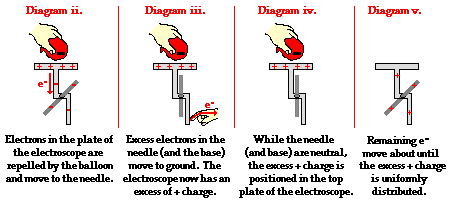Hold down the T key for 3 seconds to activate the audio accessibility mode, at which point you can click the K key to pause and resume audio. Useful for the Check Your Understanding and See Answers.
The previous section of Lesson 2 discussed the process of charging an object by friction or rubbing. Friction charging is a very common method of charging an object. However, it is not the only process by which objects become charged. In this section of Lesson 2, the charging by induction method will be discussed. Induction charging is a method used to charge an object without actually touching the object to any other charged object. An understanding of charging by induction requires an understanding of the nature of a conductor and an understanding of the polarization process. If you are not already comfortable with these topics, you might want to familiarize yourself them prior to reading further.
Charging a Two-Sphere System Using a Negatively Charged Object
 One common demonstration performed in a physics classroom involves the induction charging of two metal spheres. The metal spheres are supported by insulating stands so that any charge acquired by the spheres cannot travel to the ground. The spheres are placed side by side (see diagram i. below) so as to form a two-sphere system. Being made of metal (a conductor), electrons are free to move between the spheres - from sphere A to sphere B and vice versa. If a rubber balloon is charged negatively (perhaps by rubbing it with animal fur) and brought near the spheres, electrons within the two-sphere system will be induced to move away from the balloon. This is simply the principle that like charges repel. Being charged negatively, the electrons are repelled by the negatively charged balloon. And being present in a conductor, they are free to move about the surface of the conductor. Subsequently, there is a mass migration of electrons from sphere A to sphere B. This electron migration causes the two-sphere system to be polarized (see diagram ii. below). Overall, the two-sphere system is electrically neutral. Yet the movement of electrons out of sphere A and into sphere B separates the negative charge from the positive charge. Looking at the spheres individually, it would be accurate to say that sphere A has an overall positive charge and sphere B has an overall negative charge. Once the two-sphere system is polarized, sphere B is physically separated from sphere A using the insulating stand. Having been pulled further from the balloon, the negative charge likely redistributes itself uniformly about sphere B (see diagram iii. below). Meanwhile, the excess positive charge on sphere A remains located near the negatively charged balloon, consistent with the principle that opposite charges attract. As the balloon is pulled away, there is a uniform distribution of charge about the surface of both spheres (see diagram iv. below). This distribution occurs as the remaining electrons in sphere A move across the surface of the sphere until the excess positive charge is uniformly distributed. (This distribution of positive charge on a conductor was discussed in detail earlier in Lesson 1.)
One common demonstration performed in a physics classroom involves the induction charging of two metal spheres. The metal spheres are supported by insulating stands so that any charge acquired by the spheres cannot travel to the ground. The spheres are placed side by side (see diagram i. below) so as to form a two-sphere system. Being made of metal (a conductor), electrons are free to move between the spheres - from sphere A to sphere B and vice versa. If a rubber balloon is charged negatively (perhaps by rubbing it with animal fur) and brought near the spheres, electrons within the two-sphere system will be induced to move away from the balloon. This is simply the principle that like charges repel. Being charged negatively, the electrons are repelled by the negatively charged balloon. And being present in a conductor, they are free to move about the surface of the conductor. Subsequently, there is a mass migration of electrons from sphere A to sphere B. This electron migration causes the two-sphere system to be polarized (see diagram ii. below). Overall, the two-sphere system is electrically neutral. Yet the movement of electrons out of sphere A and into sphere B separates the negative charge from the positive charge. Looking at the spheres individually, it would be accurate to say that sphere A has an overall positive charge and sphere B has an overall negative charge. Once the two-sphere system is polarized, sphere B is physically separated from sphere A using the insulating stand. Having been pulled further from the balloon, the negative charge likely redistributes itself uniformly about sphere B (see diagram iii. below). Meanwhile, the excess positive charge on sphere A remains located near the negatively charged balloon, consistent with the principle that opposite charges attract. As the balloon is pulled away, there is a uniform distribution of charge about the surface of both spheres (see diagram iv. below). This distribution occurs as the remaining electrons in sphere A move across the surface of the sphere until the excess positive charge is uniformly distributed. (This distribution of positive charge on a conductor was discussed in detail earlier in Lesson 1.)
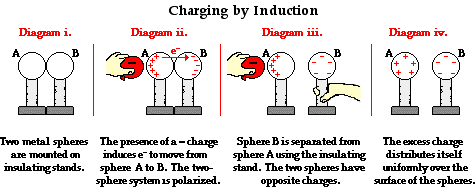
The Law of Conservation of Charge
The law of conservation of charge is easily observed in the induction charging process. Considering the example above, one can look at the two spheres as a system. Prior to the charging process, the overall charge of the system was zero. There were equal numbers of protons and electrons within the two spheres. In diagram ii. above, electrons were induced into moving from sphere A to sphere B. At this point, the individual spheres become charged. The quantity of positive charge on sphere A equals the quantity of negative charge on sphere B. If sphere A has 1000 units of positive charge, then sphere B has 1000 units of negative charge. Determining the overall charge of the system is easy arithmetic; it is simply the sum of the charges on the individual spheres.
Overall Charge of Two Spheres = +1000 units + (-1000 units) = 0 units
The overall charge on the system of two objects is the same after the charging process as it was before the charging process. Charge is neither created nor destroyed during this charging process; it is simply transferred from one object to the other object in the form of electrons.
Charging a Two-Sphere System Using a Positively Charged Object
The above examples show how a negatively charged balloon is used to polarize a two-sphere system and ultimately charge the spheres by induction. But what would happen to sphere A and sphere B if a positively charged object was used to first polarize the two-sphere system? How would the outcome be different and how would the electron movement be altered?
Consider the graphic below in which a positively charged balloon is brought near Sphere A. The presence of the positive charge induces a mass migration of electrons from sphere B towards (and into) sphere A. This movement is induced by the simple principle that opposites attract. Negatively charged electrons throughout the two-sphere system are attracted to the positively charged balloon. This movement of electrons from sphere B to sphere A leaves sphere B with an overall positive charge and sphere A with an overall negative charge. The two-sphere system has been polarized. With the positively charged balloon still held nearby, sphere B is physically separated from sphere A. The excess positive charge is uniformly distributed across the surface of sphere B. The excess negative charge on sphere A remains crowded towards the left side of the sphere, positioning itself close to the balloon. Once the balloon is removed, electrons redistribute themselves about sphere A until the excess negative charge is evenly distributed across the surface. In the end, sphere A becomes charged negatively and sphere B becomes charged positively.
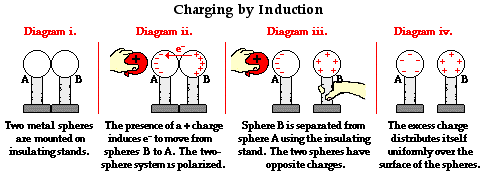
This induction charging process can be used to charge a pair of pop cans. It is a simple enough experiment to be repeated at home. Two pop cans are mounted on Styrofoam cups using scotch tape. The cans are placed side-by-side and a negatively charged rubber balloon (having been rubbed with animal fur) is brought near to one of the cans. The presence of the negative charge near a can induces electron movement from Can A to Can B (see diagram). Once the cans are separated, the cans are charged. The type of charge on the cans can be tested by seeing if they attract the negatively charged balloon or repel the negatively charged balloon. Of course, we would expect that Can A (being positively charged) would attract the negatively charged balloon and Can B (being negatively charged) should repel the negatively charged balloon. During the process of induction charging, the role of the balloon is to simply induce a movement of electrons from one can to the other can. It is used to polarize the two-can system. The balloon never does supply electrons to can A (unless your hear a spark, indicating a lightning discharge from the balloon to the can).

The Importance of a Ground in Induction Charging
In the charging by induction cases discussed above, the ultimate charge on the object is never the result of electron movement from the charged object to the originally neutral objects. The balloon never transfers electrons to or receive electrons from the spheres; nor does the glass rod transfer electrons to or receive electrons from the spheres. The neutral object nearest the charged object (sphere A in these discussions) acquires its charge from the object to which it is touched. In the above cases, the second sphere is used to supply the electrons to sphere A or to receive electrons from sphere A. The role of sphere B in the above examples is to serve as a supplier or receiver of electrons in response to the object that is brought near sphere A. In this sense, sphere B acts like a ground.
To further illustrate the importance of a ground, consider the induction charging of a single conducting sphere. Suppose that a negatively charged rubber balloon is brought near a single sphere as shown below (Diagram ii). The presence of the negative charge will induce electron movement in the sphere. Since like charges repel, negative electrons within the metal sphere will be repelled by the negatively charged balloon. There will be a mass migration of electrons from the left side of the sphere to the right side of the sphere causing charge within the sphere to become polarized (Diagram ii). Once charge within the sphere has become polarized, the sphere is touched. The touching of the sphere allows electrons to exit the sphere and move through the hand to "the ground" (Diagram iii). It is at this point that the sphere acquires a charge. With electrons having left the sphere, the sphere acquires a positive charge (Diagram iv). Once the balloon is moved away from the sphere, the excess positive charge redistributes itself (by the movement of remaining electrons) such that the positive charge is uniformly distributed about the sphere's surface.
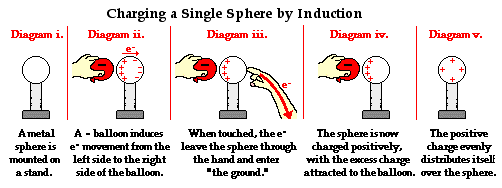
There are several things to note about this example of induction charging. First, observe that the third step of the process involves the touching of the sphere by a person. The person serves the role of the ground. If compared to the induction charging of a two-sphere system, the person has simply replaced the second sphere (Sphere B). Electrons within the sphere are repelled by the negative balloon and make an effort to distance themselves from it in order to minimize the repulsive affects. (This distance factor will be discussed in great detail in Lesson 3). While these electrons crowd to the right side of the sphere to distance themselves from the negatively charged balloon, they encounter another problem. In human terms, it could be said that the excess electrons on the right side of the sphere not only find the balloon to be repulsive, they also find each other to be repulsive. They simply need more space to distance themselves from the balloon as well as from each other. Quite regrettably for these electrons, they have run out of real estate; they cannot go further than the boundary of the sphere. Too many electrons in the same neighborhood is not a good thing. And when the hand comes nearby, these negative electrons see opportunity to find more real estate - a vast body of a human being into which they can roam and subsequently distance themselves even further from each other. It is in this sense, that the hand and the body to which it is attached (assuming of course that the hand is attached to a body) serve as a ground. A ground is simply a large object that serves as an almost infinite source of electrons or sink for electrons. A ground contains such vast space that it is the ideal object to either receive electrons or supply electrons to whatever object needs to get rid of them or receive them.
The second thing to note about the induction charging process shown above is that the sphere acquires a charge opposite the balloon. This will always be the observed case. If a negatively charged object is used to charge a neutral object by induction, then the neutral object will acquire a positive charge. And if a positively charged object is used to charge a neutral object by induction, then the neutral object will acquire a negative charge. If you understand the induction charging process, you can see why this would always be the case. The charged object that is brought near will always repel like charges and attract opposite charges. Either way, the object being charged acquires a charge that is opposite the charge of the object used to induce the charge. To further illustrate this, the diagram below shows how a positively charged balloon will charge a sphere negatively by induction.
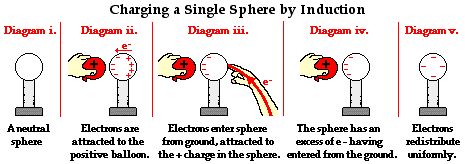
The Electrophorus
A commonly used lab activity that demonstrates the induction charging method is the Electrophorus Lab. In this lab, a flat plate of foam is rubbed with animal fur in order to impart a negative charge to the foam. Electrons are transferred from the animal fur to the more electron-loving foam (Diagram i.). An aluminum pie plate is taped to a Styrofoam cup; the aluminum is a conductor and the Styrofoam serves as an insulating handle. As the aluminum plate is brought near, electrons within the aluminum are repelled by the negatively charged foam plate. There is a mass migration of electrons to the rim of the aluminum pie plate. At this point, the aluminum pie plate is polarized, with the negative charge located along the upper rim farthest from the foam plate (Diagram ii.). The rim of the plate is then touched, providing a pathway from the aluminum plate to the ground. Electrons along the rim are not only repelled by the negative foam plate, they are also repelled by each other. So once touched, there is a mass migration of electrons from the rim to the person touching the rim (Diagram iii.). Being of much greater size than the aluminum pie plate, the person provides more space for the mutually repulsive electrons. The moment that electrons depart from the aluminum plate, the aluminum can be considered a charged object. Having lost electrons, the aluminum possesses more protons than electrons and is therefore positively charged. Once the foam plate is removed, the excess positive charge becomes distributed about the surface of the aluminum plate in order to minimize the overall repulsive forces between them (Diagram iv.).
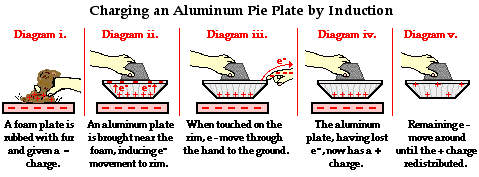
The Electrophorus Lab further illustrates that when charging a neutral object by induction, the charge imparted to the object is opposite that of the object used to induce the charge. In this case, the foam plate was negatively charged and the aluminum plate became positively charged. The lab also illustrates that there is never a transfer of electrons between the foam plate and the aluminum plate. The aluminum plate becomes charged by a transfer of electrons to the ground. Finally, one might note that the role of the charged object in induction charging is to simply polarize the object being charged. This polarization occurs as the negative foam plate repels electrons from the near side, inducing them to move to the opposite side of the aluminum plate. The presence of the positive charge on the bottom of the aluminum plate is the result of the departure of electrons from that location. Protons did not move downwards through the aluminum. The protons were always there from the beginning; it's just that they have lost their electron partners. Protons are fixed in place and incapable of moving in any electrostatic experiment.
The Electroscope
Another common lab experience that illustrates the induction charging method is the Electroscope Lab. In the Electroscope Lab, a positively charged object such as an aluminum pie plate is used to charge an electroscope by induction. An electroscope is a device that is capable of detecting the presence of a charged object. It is often used in electrostatic experiments and demonstrations in order to test for charge and to deduce the type of charge present on an object. There are all kinds of varieties and brands of electroscope from the gold leaf electroscope to the needle electroscope.
While there are different types of electroscopes, the basic operation of each is the same. The electroscope typically consists of a conducting plate or knob, a conducting base and either a pair of conducting leaves or a conducting needle. Since the operating parts of an electroscope are all conducting, electrons are capable of moving from the plate or knob on the top of the electroscope to the needle or leaves in the bottom of the electroscope. Objects are typically touched to or held nearby the plate or knob, thus inducing the movement of electrons into the needle or the leaves (or from the needle/leaves to the plate/knob). The gold leaves or needle of the electroscope are the only mobile parts. Once an excess of electrons (or a deficiency of electrons) is present in the needle or the gold leaves, there will be a repulsive affect between like charges causing the leaves to repel each other or the needle to be repelled by the base that it rests upon. Whenever this movement of the leaves/needle is observed, one can deduce that an excess of charge - either positive or negative - is present there. It is important to note that the movement of the leaves and needle never directly indicate the type of charge on the electroscope; it only indicates that the electroscope is detecting a charge.

Suppose a needle electroscope is used to demonstrate induction charging. An aluminum pie plate is first charged positively by the process of induction (see discussion above). The aluminum plate is then held above the plate of the electroscope. Since the aluminum pie plate is not touched to the electroscope, the charge on the aluminum plate is NOT conducted to the electroscope. Nonetheless, the aluminum pie plate does have an affect upon the electrons in the electroscope. The pie plate induces electrons within the electroscope to move. Since opposites attract, a countless number of negatively charged electrons are drawn upwards towards the top of the electroscope. Having lost numerous electrons, the bottom of the electroscope has a temporarily induced positive charge. Having gained electrons, the top of the electroscope has a temporarily induced negative charge (Diagram ii. below). At this point the electroscope is polarized; however, the overall charge of the electroscope is neutral. The charging step then occurs as the bottom of the electroscope is touched to the ground. Upon touching the bottom of the electroscope, electrons enter the electroscope from the ground. One explanation of their entry is that they are drawn into the bottom of the electroscope by the presence of the positive charge at the bottom of the electroscope. Since opposites attract, electrons are drawn towards the bottom of the electroscope (Diagram iii.). As electrons enter, the needle of the electroscope is observed to return to the neutral position. This needle movement is the result of negative electrons neutralizing the previously positively charged needle at the bottom of the electroscope. At this point, the electroscope has an overall negative charge. The needle does not indicate this charge because the excess of electrons is still concentrated in the top plate of the electroscope; they are attracted to the positively charged aluminum pie plate that is held above the electroscope (Diagram iv.). Once the aluminum pie plate is pulled away, the excess of electrons in the electroscope redistribute themselves about the conducting parts of the electroscope. As they do, numerous excess electrons enter the needle and the base upon which the needle rests. The presence of excess negative charged in the needle and the base causes the needle to deflect, indicating that the electroscope has been charged (Diagram v.).
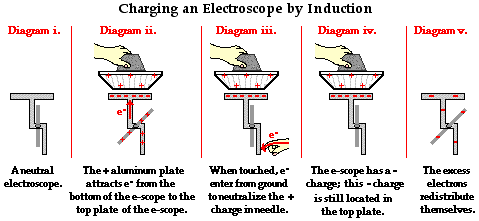
The above discussion provides one more illustration of the fundamental principles regarding induction charging. These fundamental principles have been illustrated in each example of induction charging discussed on this page. The principles are:
- The charged object is never touched to the object being charged by induction.
- The charged object does not transfer electrons to or receive electrons from the object being charged.
- The charged object serves to polarize the object being charged.
- The object being charged is touched by a ground; electrons are transferred between the ground and the object being charged (either into the object or out of it).
- The object being charged ultimately receives a charge that is opposite that of the charged object that is used to polarize it.
We Would Like to Suggest ...

Sometimes it isn't enough to just read about it. You have to interact with it! And that's exactly what you do when you use one of The Physics Classroom's Interactives. We would like to suggest that you combine the reading of this page with the use of our
Charging Interactive. You can find it in the Physics Interactives section of our website. The
Charging Interactive is an electrostatics "playground" that allows a learner to investigate a variety of concepts related to charge, charge interactions, charging processes, and grounding. Once you get the hang of the concepts, put your game-face on tap the Play button.
Check Your Understanding
Use your understanding of charge to answer the following questions. When finished, click the button to view the answers.
1. Two neutral conducting pop cans are touching each other. A positively charged balloon is brought near one of the cans as shown below. The cans are separated while the balloon is nearby, as shown. After the balloon is removed the cans are brought back together. When touching again, can X is ____.
|
a. positively charged
|
b. negatively charged
|
|
c. neutral
|
d. impossible to tell
|

 2. Two neutral conducting pop cans are touching each other. A positively charged glass rod is brought near Can X as shown below. Which of the following occur as the glass rod approaches Can X? List all that apply.
2. Two neutral conducting pop cans are touching each other. A positively charged glass rod is brought near Can X as shown below. Which of the following occur as the glass rod approaches Can X? List all that apply.
a. Electrons jump from the glass rod to can X.
b. Electrons jump from the glass rod to can Y.
c. Electrons jump from can X to the glass rod.
d. Electrons jump from can Y to the glass rod.
e. Protons jump from the glass rod to can X.
f. Protons jump from can X to the glass rod.
g. ... nonsense! None of these occur.
 3. TRUE or FALSE?
3. TRUE or FALSE?
Two neutral conducting pop cans are touching each other. A negatively charged balloon is brought near Can X as shown below. As the balloon approaches Can X, there is a movement of electrons between the balloon and can X (in one direction or the other).
4. A positively charged balloon is brought near a neutral conducting sphere as shown below. While the balloon is near, the sphere is touched (grounded).

At this point, there is a movement of electrons. Electrons move ____ .
a. into the sphere from the ground (hand)
b. out of the sphere into the ground (hand)
c. into the sphere from the balloon
d. out of the sphere into the balloon
e. from the ground through the sphere to the balloon
f. from the balloon through the sphere to the ground
g. .... nonsense! Electrons do not move at all.
5. Suppose that a negatively charged balloon is used to charge an electroscope by induction. The procedural steps are described in the educational cartoon below. On the cartoon, draw the orientation of the needle and indicate the location and type of any excess charge in steps ii. - v. Explain in terms of electron movement what is happening in each step.
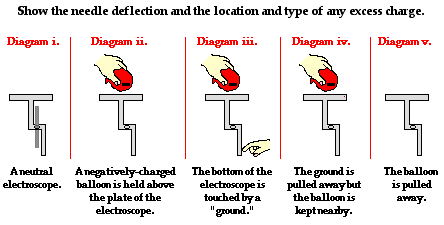
View Answer.
6. A negatively charged balloon is brought near a neutral conducting sphere as shown below. As it approaches, charge within the sphere will distribute itself in a very specific manner. Which one of the diagrams below properly depicts the distribution of charge in the sphere?

7. A positively charged piece of Styrofoam is placed on the table. A neutral aluminum pie plate is brought near as shown below. While held above the Styrofoam, the aluminum plate is touched (grounded).

At this point, there is a movement of electrons. Electrons move ____ .
a. out of the aluminum plate into the ground (hand)
b. into the aluminum plate from the ground (hand)
c. into the aluminum plate from the Styrofoam
d. out of the aluminum plate into the Styrofoam
e. from the ground through the aluminum plate to the Styrofoam
f. from the Styrofoam through the aluminum plate to the ground
g. .... nonsense! Electrons do not move at all.
Answer to Question #5:
